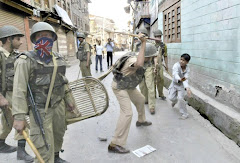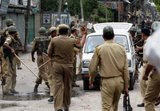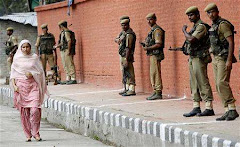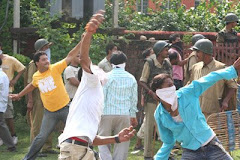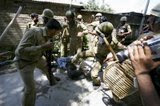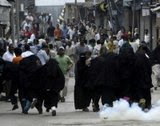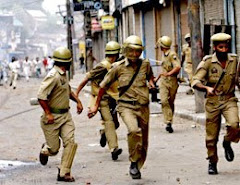
Ragda II may not return soon but New Delhi’s claim of restoring democracy is in tatters
Courtesy: Daily Rising Kashmir dt. Feb., 26th, 2009 by Riyaz Masroor
The killing of two youth in the unprovoked firing by army at Bomai, Sopore, on February 21 and the excesses by Police and paramilitary troops against the protesting masses is a big challenge for India. It’s, in fact, bigger than the country has met in Kashmir earlier in the form of a deadly spell of Pakistan-sponsored militancy. It’s not challenging just in the sense that India cannot ‘take care’ of the new phases of resistance or does not know the ‘method’. It is challenging primarily because in November-December 2008 India had got a windfall in the form of 62 percent voter participation, that too without open coercion and with the fresh background of a successful mass mobilization for Azadi – the background in a way suited for selling elections to the world. It’s challenging also because the pro-democracy voices from within the society had become louder and the rhetorical aversion of separatist leaders toward the concept of democracy was being mocked in chat rooms and gossip lounges. Also, even Pakistan was dropping broader hints that Kashmiris better take recourse to the democratic means of resistance. In sum, the model of democracy despite having been abused shamelessly in Kashmir by Indian government (remember 1951, 53, 84, 77, 87, 1996) was again in currency, much to the comfort of India’s Kashmir handlers.
Whether the 2008 elections had bolstered India’s foreign policy discourse vis-à-vis Kashmir dispute remains debatable. What is of significant note is the elections and the formation of the new Congress-NC government, Kashmir had witnessed a lull in separatism and any return of the uprising of last summer, which came to be known as Ragda movement, was hardly predicted. None would say there would be no Ragda 2 but none would anticipate it returning so quickly without even the chief minister completing 60 days in office. The fresh unrest that was sparked by the killing of two youth in Sopore on February 21 during an army shootout, may not sustain as longer as the Ragda 1 but the expression of anger that is writ on the face of every youth, from Srinagar to Sopore sounds an alarm that the summer of 2009 or may be the autumn could be greeted by a rather more troubling Ragda. On February 24, when the news about the mysterious murder of the close relative of a top separatist leader, Muhammad Yasin Malik broke in the Town, the anger got fueled further. We saw anguished youth in Srinagar scaling life-size hoardings, which depicted the India’s most influential woman and Congress Chief Sonia Gandhi alongside her son Rahul Gandhi and Prime Minister Manmohan Singh. The masked youth would defile the images and shred them down with vindictive rage, burn down the traffic beats and move on with vengeful expressions.
As this was happening Sonia’s and Singh’s responses to Kashmir elections were still fresh in popular memory here. Just ten days ago, on February 14, during the inauguration of Srinagar International Airport, Sonia Gandhi had asserted that the formation of new government and “restoration of democracy” was a gift (from New Delhi) to Kashmiris. “The overwhelming response shown by the people of Jammu and Kashmir in the assembly elections shows their faith in democracy. People actively participated in the elections and elected the government. And they showed that democracy is the true means to achieve peace and development,” Gandhi said in a brief 15-minute speech on the newly constructed Airport terminal at Srinagar. She also ridiculed the separatist policies and asked Hurriyat leadership that they should draw a lesson from the massive voter participation. Past year on December 28, when the election results were out, Prime Minister Manmohan Singh and Sonia Gandhi were attending a special function in New Delhi to mark the 123rd Foundation Day of the Congress party. On the flanks of this function the Prime Minister Singh and Sonia while speaking to newsmen termed the election results as the “vote for democracy” and a “lesson to be learnt by our neighbors”. According to an Indian Express report Singh and Gandhi said, "It is a vote for democracy. It is a vote for national integration. As far as who wins or who loses is a secondary issue … it doesn't matter who wins, what matters is that the people of the valley, the people of Jammu and Kashmir have placed their full faith in the democratic system which is a lesson to be learnt by our neighbors." Both Singh and Sonia were right in a greater measure. If people voted, although with limited expectations, it was a loud expression that they have believed once again in the democratic concept. But this faith is now once more shaken, unfortunately this time irreparably, by none other than the army that is supposedly here for “winning hearts and minds”. How many hearts and minds would every incident like Bomai win for India?
Indeed the killing of Javed and Amin of Sopore has dispelled the much projected impression that the civilian government in Kashmir could be any better than the Governor Raj, which is perceived as the direct army rule. And, the people now seem convinced that elections howsoever participatory and clean hardly matter when it comes to passing through an army camp. So, if people really voted for democracy they must be surprised to see bullets greeting their vote. Diplomatic costs for New Delhi are far too visible to be downplayed but the political costs for Congress-NC coalition in J&K are colossal. The incident will give Mufti Muhammad Sayeed a ‘benefit of doubt’ and he would try to project himself as the only CM in the past decade and a half who could ensure security and could rein in the armed forces in J&K. How could he do that? That is a separate subject but he has already grabbed the opportunity by highlighting the need to abrogate the draconian Armed Forces Special Powers Act, which gives the troops the ‘license to kill’. Moreover, Omar Abdullah is currently banking on tourism campaign to showcase his government’s ability to bring the troubled Kashmir back on track. But the incidents like Bomai and the subsequent demonstrations would be a bad advertisement of J&K government.
The killing of two youth in the unprovoked firing by army at Bomai, Sopore, on February 21 and the excesses by Police and paramilitary troops against the protesting masses is a big challenge for India. It’s, in fact, bigger than the country has met in Kashmir earlier in the form of a deadly spell of Pakistan-sponsored militancy. It’s not challenging just in the sense that India cannot ‘take care’ of the new phases of resistance or does not know the ‘method’. It is challenging primarily because in November-December 2008 India had got a windfall in the form of 62 percent voter participation, that too without open coercion and with the fresh background of a successful mass mobilization for Azadi – the background in a way suited for selling elections to the world. It’s challenging also because the pro-democracy voices from within the society had become louder and the rhetorical aversion of separatist leaders toward the concept of democracy was being mocked in chat rooms and gossip lounges. Also, even Pakistan was dropping broader hints that Kashmiris better take recourse to the democratic means of resistance. In sum, the model of democracy despite having been abused shamelessly in Kashmir by Indian government (remember 1951, 53, 84, 77, 87, 1996) was again in currency, much to the comfort of India’s Kashmir handlers.
Whether the 2008 elections had bolstered India’s foreign policy discourse vis-à-vis Kashmir dispute remains debatable. What is of significant note is the elections and the formation of the new Congress-NC government, Kashmir had witnessed a lull in separatism and any return of the uprising of last summer, which came to be known as Ragda movement, was hardly predicted. None would say there would be no Ragda 2 but none would anticipate it returning so quickly without even the chief minister completing 60 days in office. The fresh unrest that was sparked by the killing of two youth in Sopore on February 21 during an army shootout, may not sustain as longer as the Ragda 1 but the expression of anger that is writ on the face of every youth, from Srinagar to Sopore sounds an alarm that the summer of 2009 or may be the autumn could be greeted by a rather more troubling Ragda. On February 24, when the news about the mysterious murder of the close relative of a top separatist leader, Muhammad Yasin Malik broke in the Town, the anger got fueled further. We saw anguished youth in Srinagar scaling life-size hoardings, which depicted the India’s most influential woman and Congress Chief Sonia Gandhi alongside her son Rahul Gandhi and Prime Minister Manmohan Singh. The masked youth would defile the images and shred them down with vindictive rage, burn down the traffic beats and move on with vengeful expressions.

As this was happening Sonia’s and Singh’s responses to Kashmir elections were still fresh in popular memory here. Just ten days ago, on February 14, during the inauguration of Srinagar International Airport, Sonia Gandhi had asserted that the formation of new government and “restoration of democracy” was a gift (from New Delhi) to Kashmiris. “The overwhelming response shown by the people of Jammu and Kashmir in the assembly elections shows their faith in democracy. People actively participated in the elections and elected the government. And they showed that democracy is the true means to achieve peace and development,” Gandhi said in a brief 15-minute speech on the newly constructed Airport terminal at Srinagar. She also ridiculed the separatist policies and asked Hurriyat leadership that they should draw a lesson from the massive voter participation. Past year on December 28, when the election results were out, Prime Minister Manmohan Singh and Sonia Gandhi were attending a special function in New Delhi to mark the 123rd Foundation Day of the Congress party. On the flanks of this function the Prime Minister Singh and Sonia while speaking to newsmen termed the election results as the “vote for democracy” and a “lesson to be learnt by our neighbors”. According to an Indian Express report Singh and Gandhi said, "It is a vote for democracy. It is a vote for national integration. As far as who wins or who loses is a secondary issue … it doesn't matter who wins, what matters is that the people of the valley, the people of Jammu and Kashmir have placed their full faith in the democratic system which is a lesson to be learnt by our neighbors." Both Singh and Sonia were right in a greater measure. If people voted, although with limited expectations, it was a loud expression that they have believed once again in the democratic concept. But this faith is now once more shaken, unfortunately this time irreparably, by none other than the army that is supposedly here for “winning hearts and minds”. How many hearts and minds would every incident like Bomai win for India?
Indeed the killing of Javed and Amin of Sopore has dispelled the much projected impression that the civilian government in Kashmir could be any better than the Governor Raj, which is perceived as the direct army rule. And, the people now seem convinced that elections howsoever participatory and clean hardly matter when it comes to passing through an army camp. So, if people really voted for democracy they must be surprised to see bullets greeting their vote. Diplomatic costs for New Delhi are far too visible to be downplayed but the political costs for Congress-NC coalition in J&K are colossal. The incident will give Mufti Muhammad Sayeed a ‘benefit of doubt’ and he would try to project himself as the only CM in the past decade and a half who could ensure security and could rein in the armed forces in J&K. How could he do that? That is a separate subject but he has already grabbed the opportunity by highlighting the need to abrogate the draconian Armed Forces Special Powers Act, which gives the troops the ‘license to kill’. Moreover, Omar Abdullah is currently banking on tourism campaign to showcase his government’s ability to bring the troubled Kashmir back on track. But the incidents like Bomai and the subsequent demonstrations would be a bad advertisement of J&K government.
















